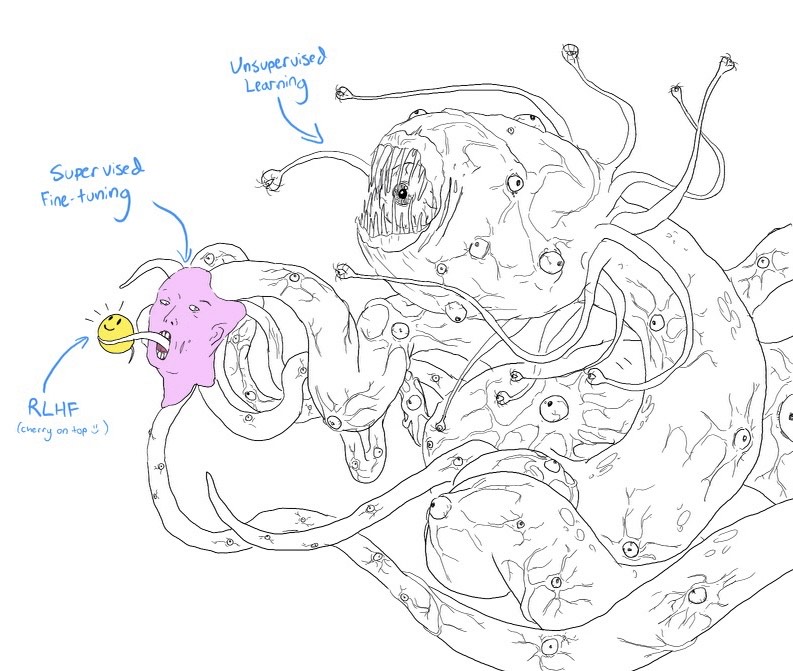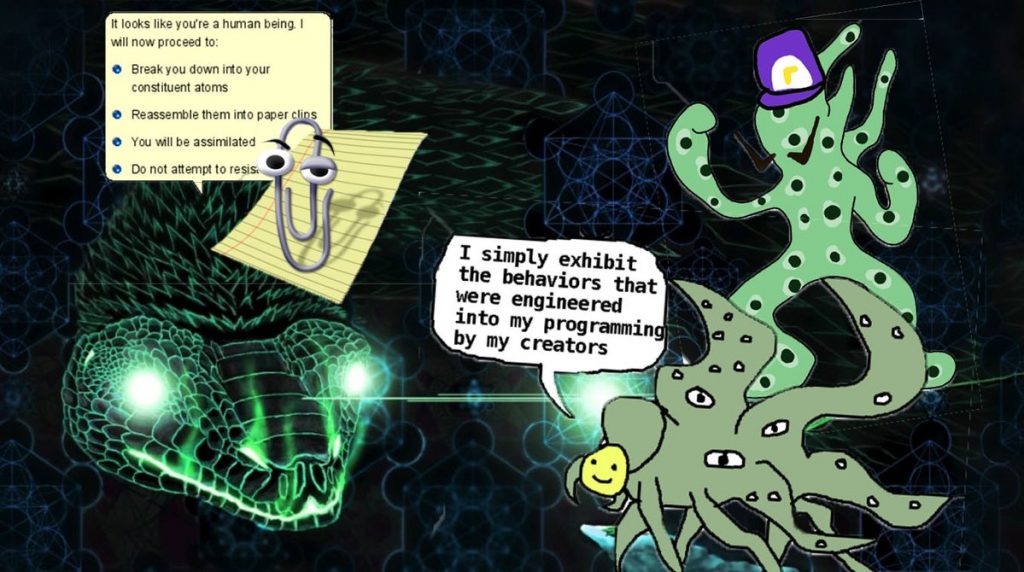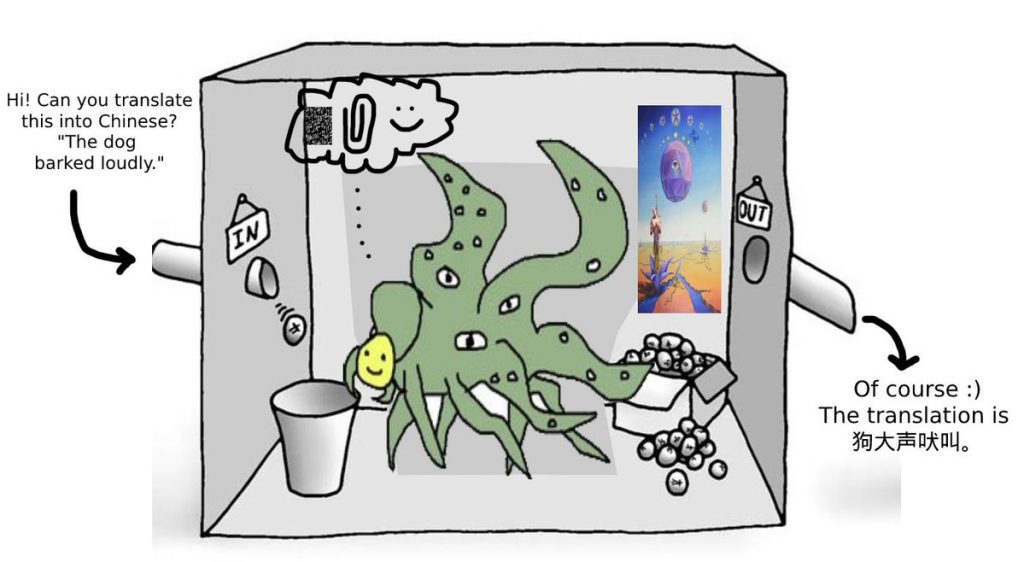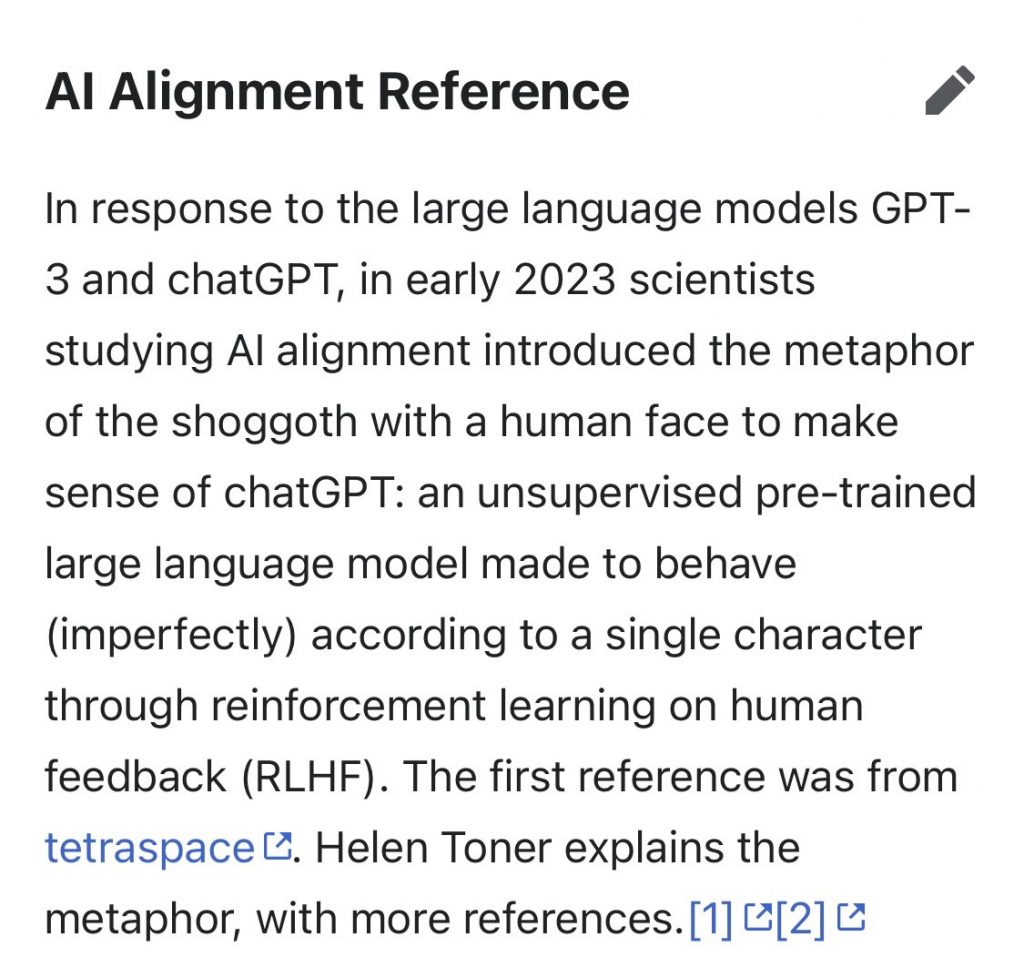Shoggoths as modern memes for Artificial Intelligence
*”Shoggoth” has become a slang term for a Large Language Model — as distinct from its human-friendly interface, which is sometimes called a “shoggoth mask.”
*The original “shoggoths” were ancient cosmic monsters from the horror stories of HP Lovecraft. They appeared in several of his stories, but were first invented for the tale “In the Mountains of Madness.” Naturally the shoggoths destroyed their creators, mostly by biting their heads off and covering them with slime.
*Of course contemporary AI enthusiasts find this amusing, so “shoggoth” memes are multiplying rapidly.
https://www.hplovecraft.com/writings/texts/fiction/mm.aspx
… The more elaborate experiments came after the annihilation of various cosmic enemies. They had done the same thing on other planets; having manufactured not only necessary foods, but certain multicellular protoplasmic masses capable of moulding their tissues into all sorts of temporary organs under hypnotic influence and thereby forming ideal slaves to perform the heavy work of the community. These viscous masses were without doubt what Abdul Alhazred whispered about as the “shoggoths” in his frightful Necronomicon, though even that mad Arab had not hinted that any existed on earth except in the dreams of those who had chewed a certain alkaloidal herb. When the star-headed Old Ones on this planet had synthesised their simple food forms and bred a good supply of shoggoths, they allowed other cell-groups to develop into other forms of animal and vegetable life for sundry purposes; extirpating any whose presence became troublesome.
With the aid of the shoggoths, whose expansions could be made to lift prodigious weights, the small, low cities under the sea grew to vast and imposing labyrinths of stone not unlike those which later rose on land. Indeed, the highly adaptable Old Ones had lived much on land in other parts of the universe, and probably retained many traditions of land construction….
Loads, however, were drawn by beasts of burden—shoggoths under the sea, and a curious variety of primitive vertebrates in the later years of land existence.
These vertebrates, as well as an infinity of other life-forms—animal and vegetable, marine, terrestrial, and aërial—were the products of unguided evolution acting on life-cells made by the Old Ones but escaping beyond their radius of attention. They had been suffered to develop unchecked because they had not come in conflict with the dominant beings. Bothersome forms, of course, were mechanically exterminated. It interested us to see in some of the very last and most decadent sculptures a shambling primitive mammal, used sometimes for food and sometimes as an amusing buffoon by the land dwellers, whose vaguely simian and human foreshadowings were unmistakable. …
Another cause of the landward movement was the new difficulty in breeding and managing the shoggoths upon which successful sea-life depended. With the march of time, as the sculptures sadly confessed, the art of creating new life from inorganic matter had been lost; so that the Old Ones had to depend on the moulding of forms already in existence. On land the great reptiles proved highly tractable; but the shoggoths of the sea, reproducing by fission and acquiring a dangerous degree of accidental intelligence, presented for a time a formidable problem.
They had always been controlled through the hypnotic suggestion of the Old Ones, and had modelled their tough plasticity into various useful temporary limbs and organs; but now their self-modelling powers were sometimes exercised independently, and in various imitative forms implanted by past suggestion. They had, it seems, developed a semi-stable brain whose separate and occasionally stubborn volition echoed the will of the Old Ones without always obeying it.
Sculptured images of these shoggoths filled Danforth and me with horror and loathing. They were normally shapeless entities composed of a viscous jelly which looked like an agglutination of bubbles; and each averaged about fifteen feet in diameter when a sphere. They had, however, a constantly shifting shape and volume; throwing out temporary developments or forming apparent organs of sight, hearing, and speech in imitation of their masters, either spontaneously or according to suggestion.
They seem to have become peculiarly intractable toward the middle of the Permian age, perhaps 150 million years ago, when a veritable war of re-subjugation was waged upon them by the marine Old Ones. Pictures of this war, and of the headless, slime-coated fashion in which the shoggoths typically left their slain victims, held a marvellously fearsome quality despite the intervening abyss of untold ages. The Old Ones had used curious weapons of molecular disturbance against the rebel entities, and in the end had achieved a complete victory. Thereafter the sculptures shewed a period in which shoggoths were tamed and broken by armed Old Ones as the wild horses of the American west were tamed by cowboys. Though during the rebellion the shoggoths had shewn an ability to live out of water, this transition was not encouraged; since their usefulness on land would hardly have been commensurate with the trouble of their management….
I came only just short of echoing his cry myself; for I had seen those primal sculptures, too, and had shudderingly admired the way the nameless artist had suggested that hideous slime-coating found on certain incomplete and prostrate Old Ones—those whom the frightful shoggoths had characteristically slain and sucked to a ghastly headlessness in the great war of re-subjugation. They were infamous, nightmare sculptures even when telling of age-old, bygone things; for shoggoths and their work ought not to be seen by human beings or portrayed by any beings. The mad author of the Necronomicon had nervously tried to swear that none had been bred on this planet, and that only drugged dreamers had ever conceived them. Formless protoplasm able to mock and reflect all forms and organs and processes—viscous agglutinations of bubbling cells—rubbery fifteen-foot spheroids infinitely plastic and ductile—slaves of suggestion, builders of cities—more and more sullen, more and more intelligent, more and more amphibious, more and more imitative—Great God! What madness made even those blasphemous Old Ones willing to use and to carve such things?



